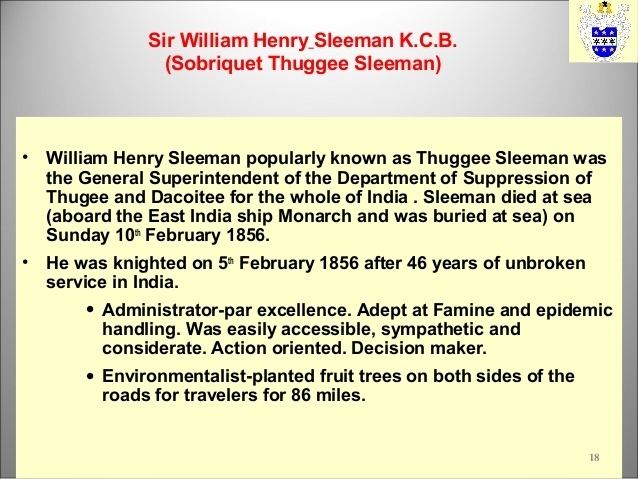Name William Sleeman Died February 10, 1856 | ||
 | ||
Occupation Army officer, civil servant Books Rambles And Recollecti, Journey Through the Kingd, Ramaseeana - or - A Vocabula, A Journey Through the Kingd, The Thugs Or Phansiga | ||
William henry sleeman the repressor of the thuggees
Major-general Sir William Henry Sleeman KCB (8 August 1788 – 10 February 1856) was a British soldier and administrator in British India, best known for his work suppressing Thuggee activity.
Contents
- William henry sleeman the repressor of the thuggees
- Early life and career
- Thugee suppression
- British Resident and later life
- Family
- In popular culture
- References

Early life and career

Sleeman was born in Stratton, Cornwall, the son of Philip Sleeman, a yeoman and supervisor of excise of St Tudy.

In 1809 Sleeman joined the Bengal Army and later served in the Nepal War between 1814–1816.

In 1820 he was selected for civil employ, and became junior assistant to the Governor-General's agent in the Saugor and Nerbudda territories. In 1822 he was placed in charge of Narsinghpur District, and would later describe his two years in the role as by far the most laborious of his life. He was gazetted to the rank of Captain in 1825, and in 1828 assumed charge of Jubbulpore District. In 1831 he transferred to Sagar district to cover for a colleague on leave. Upon his colleague's return, Sleeman continued with magisterial duties in Sagar until 1835.

Sleeman became the earliest discoverer of dinosaur fossils in Asia when in 1828, serving as a Captain in the Narmada valley region, he noticed several basaltic formations which he identified as having been "raised above the waters". By digging around in the Bara Simla Hills, part of the Lameta formation near Jabalpur, he unearthed several petrified trees, as well as some fragmentary dinosaur fossil specimens. Subsequently he sent these specimens to London and to the Indian Museum in Calcutta. In 1877 the genus was named Titanosaurus Indicus by Richard Lydekker, but the taxonomic position is in doubt. Sleeman wrote about wild children who had been raised by wolves with his notes on six cases. This was first published in the first volume of his Journey through the kingdom of Oude in 1848-1850 (1858) and reprinted in 1852 as An Account of Wolves Nurturing Children in Their Dens, by an Indian Official and in The Zoologist (1888 12(135):87-98). This caught the imagination of many and ultimately inspired Rudyard Kipling's Mowgli character.
Thugee suppression
Sleeman is best known for his work suppressing the Thuggee secret society. In 1835, he captured "Feringhea" (also called Syeed Amir Ali, on whom the novel Confessions of a Thug is based) and got him to turn King's evidence. He took Sleeman to a grave with a hundred bodies, told the circumstances of the killings, and named the Thugs who had done it. After initial investigations confirmed what Feringhea had said, Sleeman started an extensive campaign, being appointed General Superintendent of the operations for the Suppression of Thuggee and in February 1839, he assumed charge of the office of Commissioner for the Suppression of Thuggee and Dacoity. During these operations, more than 1400 Thugs were hanged or transported for life. One of them, Bahram, confessed to have strangled 931 persons with his turban. Detection was only possible by means of informers, for whose protection from the vengeance of their associates a special prison was established at Jabalpur (at the time Jubbulpore). Sleeman had a Government Report made in 1839. Sleeman wrote three books about the Thugs: Ramaseeana, or a Vocabulary of the peculiar language used by Thugs; Report on the Depredations Committed by the Thug Gangs of Upper and Central India; and The Thugs or Phansigars of India.
British Resident and later life
Sleeman served as Resident at Gwalior from 1843 to 1849, and at Lucknow from 1849 to 1856. Whilst Resident at Lucknow he survived three assassination attempts. He was also opposed to the annexation of Oudh by Lord Dalhousie, but his advice was disregarded.
Sleeman also took an interest in phrenology and believed that the measurements of the skulls could help him identify criminal ethnic groups.
He died and was buried at sea near Ceylon on a recovery trip to Britain in 1856, just six days after being awarded the Order of the Bath.
The village Sleemanabad in Madhya Pradesh, India was named in his honour.
Family
Whilst in Jubbulpore, he married Amélie Josephine, the daughter of Count Blondin de Fontenne, a French nobleman. They had seven children. His second daughter, Henrietta, was married to William Alexander Ross, an uncle of Sir Ronald Ross. A grandson of Sleeman, Colonel Sir James Lewis Sleeman who also wrote about thuggee and shikar became a pioneer of wildlife photography in India.
In popular culture
Sleeman is featured in the novel The Strangler Vine by Miranda Carter (2015)
